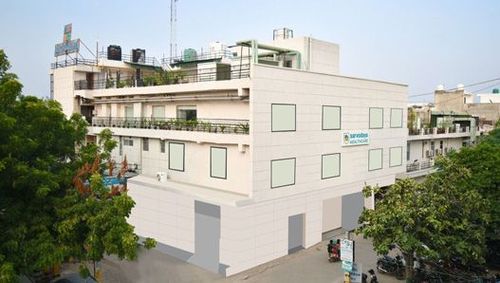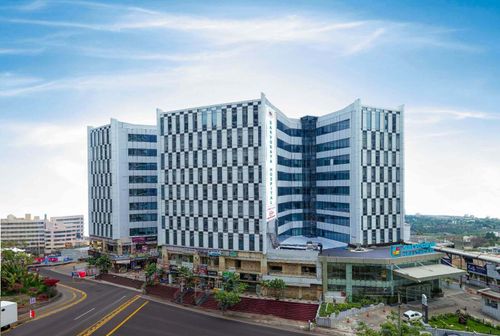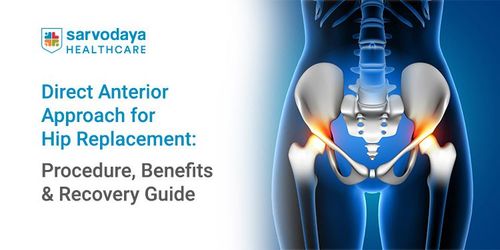Overview
Hip Replacement, or Hip Arthroplasty, is a procedure to replace a damaged hip joint with artificial components when conditions like arthritis, fractures, or degeneration cause pain and limited mobility. At Sarvodaya Hospital’s Centre for Orthopaedics, we offer both Total and Partial Hip Replacements using advanced surgical techniques to ensure accurate implant placement and optimal recovery.
Hip replacement procedures at Sarvodaya Hospital are performed using advanced minimally invasive techniques that ensure precise implant placement, reduced surgical trauma, and faster recovery. With a strong focus on patient safety and long-term mobility, our orthopaedic team delivers consistently high success rates. Recognised as the Best Hip Replacement Surgery Hospital in Faridabad Delhi NCR, we are committed to restoring joint function and improving quality of life through expert-led care.
Why is Hip Replacement Required?
Hip replacement becomes necessary when joint damage leads to chronic pain, reduced mobility, and poor quality of life. Common conditions include Osteoarthritis, the leading cause due to cartilage breakdown; Rheumatoid Arthritis, which inflames and erodes joint lining; and Avascular Necrosis, where loss of blood flow causes bone collapse.
Patients with Post-Traumatic Arthritis from fractures or injuries, and Hip Fractures, especially in the elderly, may also require surgical intervention.
Additionally, Congenital Hip Disorders and Failed Previous Hip Surgeries often lead to revision procedures. At Sarvodaya Hospital, advanced techniques performed by the best orthopaedic doctor in Delhi NCR, ensure greater precision and improved outcomes in even the most complex cases.
Surgical Approaches in Hip Replacement
Posterior Approach (Traditional)This is the most widely practised method, where the incision is made at the back of the hip. It allows good visibility of the joint but may involve more muscle disruption, leading to longer recovery times and a higher risk of dislocation in some patients.
Here, the incision is made on the outer side of the hip, passing through muscle tissue. It offers improved joint stability and is suitable for elderly or less active patients. However, it may temporarily affect gait and abductor muscle strength.
Direct Anterior Approach (DAA) for hip replacement
Sarvodaya Hospital is among the few centres in India offering the Direct Anterior Approach (DAA) for hip replacement surgery. This advanced, muscle-sparing technique accesses the joint from the front of the hip, avoiding major muscle disruption. As a result, patients benefit from smaller incisions, reduced post-operative pain, quicker rehabilitation, and a faster return to daily activities compared to traditional posterior or lateral methods. With a focus on minimally invasive orthopaedic care, Sarvodaya Hospital ensures enhanced outcomes and improved patient comfort through the DAA approach.
Procedure for Hip Replacement
The orthopaedic surgeon at Sarvodaya leverage advanced surgical techniques and high-precision tools to remove the damaged ball, socket, and cartilage, replacing them with durable metallic or ceramic prosthetics. The artificial socket, known as the acetabular prosthesis, and the ball and stem (femoral prosthesis) are securely placed in the hip using specialised instruments, often supported with screws or press-fit systems.
With a focus on accuracy and patient-specific alignment, Sarvodaya ensures smoother joint movement, reduced pain, and restored mobility, helping patients return to their daily routine confidently under the care of the best Orthopaedic Doctor in Faridabad.
Benefits of Hip Replacement
Hip replacement surgery offers life-changing relief for individuals suffering from chronic joint pain and mobility issues due to arthritis, injury, or degenerative disorders. At Sarvodaya Hospital, our expert orthopaedic team uses advanced surgical techniques and precision-driven care to restore hip function, reduce pain, and enhance quality of life.
- Pain Relief: Significant reduction or complete elimination of chronic hip pain caused by arthritis, fractures, or joint degeneration.
- Improved Mobility and Function: Restores smooth hip joint movement, making everyday activities like walking, climbing stairs, and sitting more comfortable.
- Enhanced Quality of Life: Boosts confidence and independence by allowing patients to return to normal routines and active lifestyles with ease.
- Long-Lasting Results: Modern implants ensure durable outcomes; most hip replacements last 15–20 years or more.
Post-Treatment Lifestyle Modifications
- Physical Rehabilitation: Guided physiotherapy is essential to restore strength, flexibility, and hip mobility. Regular exercises help regain natural movement patterns.
- Weight Management: Maintaining an ideal body weight reduces pressure on the implant and improves its durability.
- Activity Guidelines: Avoid high-impact sports. Opt for low-impact options like walking, swimming, or cycling.
- Home Adjustments:Use supportive furniture, handrails, and anti-slip mats to reduce fall risk during early recovery.
- Medication and Check-ups:Take all prescribed medicines and follow your surgeon’s check-up schedule to track healing and implant performance.













